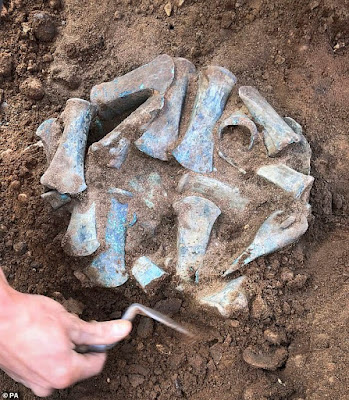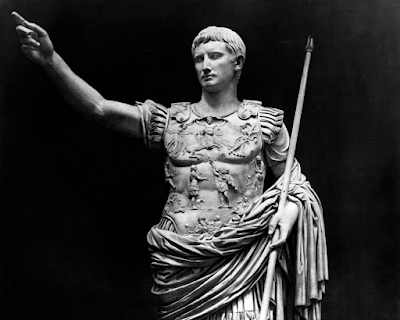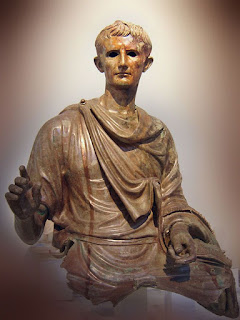Sunday, July 31, 2022
Thursday, July 28, 2022
Hoard of Bronze Age weapons found by banks of the Thames.
 The Bronze Age in Britain began around 2,000 BC and lasted for nearly 1,500 years. It was a time when sophisticated bronze tools, pots and weapons were brought over from continental Europe. | A hoard of ancient weapons discovered on a building site by the banks of the Thames in 2019 may have been an offering to the gods, experts say. The 453 artifacts date back nearly 3,000 years and were discovered in Havering, east London. Axes, swords, spears, rings, daggers and copper ingots make up the ancient collection, which dates from between 800BC and 900BC. |  |
 | The placement of hundreds of weapons carefully buried in groups close together suggests the site in Havering might have been a metal worker’s former armoury recycling metal. Many of the objects were damaged or broken. The objects will go on display for the first time at the Museum of London Docklands. |
Tuesday, July 19, 2022
German farmer awarded $904k for Roman horse head
 | Authorities paid a farmer 773k euros ($904k) for a bronze horse head dating to Roman times found on his land in 2009. The head, part of a statue of the emperor Augustus, was found in Lahnau in western Germany. |  |
 | The life-sized bronze Roman horse's head was found at the bottom of a well. The cast-bronze head, which weighs 25 kilograms, is among the best-preserved Roman bronzes in the world. It was once covered in gold leaf. A depiction of Mars, the god of war, on the horse's halter make it the mount of an important figure. The state initially paid 48k euros for the relic. |
 Equestrian Statue of Marcus Aurelius in the Capitoline Museum, Rome 176-180 CE Equestrian Statue of Marcus Aurelius in the Capitoline Museum, Rome 176-180 CE |  Lugdunum (Lyon) mint. Struck 2 BC-AD 12.  13-14 AD. Laureate head of Augustus. |  Augustus ruled from 16 January 27 BC until his death 19 August AD 14. Augustus ruled from 16 January 27 BC until his death 19 August AD 14. |
Monday, July 18, 2022
Neolithic stone mask found
Sunday, July 17, 2022
Ancient Roman sarcophagi
 The Ludovisi sarcophagus | In 2015, a routine operation to repair gas pipes beneath a street in the capital revealed the remains of a 2,000-year-old villa, complete with frescoed walls. |  A Roman sarcopagus was found at Blenheim Palace |
Saturday, July 16, 2022
4,000 yo copper weapons found in Uttar Pradesh
 | A farmer was levelling his field when he found a large number of copper swords and harpoons. He took all of them as he thought they were made of gold or silver. However, locals informed cops and the Archaeological Survey of India (ASI) swung into action. The weapons can be traced to the copper age. "These copper hoards belong to the Chalcolithic period (copper age) and the presence of Ochre Coloured Pottery is directly associated with this time." The Chalcolithic period is generally dated between 2,000 and 1,500 BCE. |
Thursday, July 14, 2022
Ancient gold coins shine but lead weights are real treasure
| Four gold coins found in a field near East Peckham could be worth more than £10,000 - but experts believe the real treasure could be a couple of nondescript lead weights. Two of the coins are 'early-medieval Merovingian gold tremissis' from around AD590-670, both minted in France - one in Senlis, and the other in St Denis. The third coin, another early-medieval gold tremissis known as a 'pale shilling' was from a later period, circa AD650-70, and likely to have been minted in either East Anglia or Kent. The fourth, thought to date back to AD590-670, was more mysterious, of "uncertain" origin. |
| The economy was a bullion-based system, with value determined by weight of precious metal, not the 'face value' of a coin. The presence of lead weights is important as the weights found were within 0.03 grams of the weight of the other coins, all of which weigh roughly 1.3 grams. Such weights were being used to assess the value of coins - but actually finding them alongside coins is extremely rare. |  |
Wednesday, July 13, 2022
Roman gold discovered in plowed UK field
 | Detectorists have discovered 11 coins on a remote stretch of cultivated field located in Norfolk, near England's eastern coast. The hoard is dated to between the first century B.C. and the first century A.D. All the coins were minted before the Roman conquest, when Britain became occupied by Roman forces in A.D. 43 after an invasion by Claudius. Two types of gold coins were found: one type was marked with the portrait of Augustus Caesar, the first emperor of Rome, with Gaius and Lucius, his grandsons and heirs to the throne. (Both grandsons died before they could become emperor.) The other featured Augustus in profile on one side, but with Gaius on horseback on the reverse. |
Sunday, July 10, 2022
Ancient Egyptian boy reconstructed
 | Researchers have unveiled a 3-D facial reconstruction of an Egyptian boy who was mummified during the first century A.D. Analysis of the skeleton’s bones and teeth suggests the boy was roughly 3 to 4 years old at the time of his death. To create the 3-D reconstruction, the researchers took computerized tomography (CT) scans of the 30-inch-long skeleton encased in the linen mummy wrappings. Their analysis suggested the boy likely succumbed to pneumonia. |
 | Researchers conclude that the similarities between the reconstruction and the portrait are so striking that the painting must have been created just before or after the boy’s death. Attaching so-called “mummy portraits” to the front of mummified corpses was a popular practice among high status Roman Egyptian society between the first and third centuries A.D. |  |
Wednesday, July 6, 2022
Vercingetorix
 | Vercingetorix (c. 82 BC – 46 BC) was a king and chieftain of the Arverni tribe; he united the Gauls in a revolt against Roman forces during the last phase of Julius Caesar's Gallic Wars. Vercingetorix came to power in 52 BC. He established an alliance with other Gallic tribes, took command of combined forces, and led them in the Celts' revolt against the Romans. He won the Battle of Gergovia against Julius Caesar in which several thousand Romans and allies died and Caesar's Roman legions withdrew. Vercingetorix waged a guerilla war. |  Vercingetorix is considered the first national hero of France and was greatly admired in his time, even by his enemies. Vercingetorix is considered the first national hero of France and was greatly admired in his time, even by his enemies. |
 | All hope was lost behind the walls in Alesia. Vercingetorix surrendered himself, taking the Romans by surprise. Caesar had him taken away in chains and sent to Rome. The defenders of Alesia were massacred, sold as slaves, or given as slaves to soldiers as spoils. Vercingetorix was exhibited in Caesar's triumph; then he was executed. |  |
Tuesday, July 5, 2022
Jewel bedecked skeleton
 | A 2000-year-old woman found buried in a Russian tomb in 2018 was bedecked in fine jewels from the Roman Empire. The remains of the high-status female was found in a tomb in the Russian republic of Kabardino-Balkaria. Two rings on her fingers were made with a cutting edge technology. |  |
 | They were cast from transparent white glass with golden fibres from the same material, with a dark glass in the middle. It is Roman-made and would have been extremely expensive. The beads on her shoes were made of glass and carnelian. She went to the afterlife wearing a bright violet amethyst medallion. The high status burial appears to be a family grave. |  |
Sunday, July 3, 2022
Napoleon's boots - $128k
 | A pair of boots belonging to Napoleon Bonaparte was expected to fetch 80,000 euros. ($88k) Auctioneers said Napoleon may have owned the leather riding boots during his final exile in Saint Helena, after his defeat at Waterloo. |  |
Saturday, July 2, 2022
Nazi Gold Train - Treasure hunters fail
 | A handful of volunteers led by gold-diggers Andreas Richter and Piotr Koper excavated along railroad tracks above the purported site of buried treasure from the dying days of the Third Reich. Richter and Koper electrified the public imagination when they announced they’d discovered evidence of a treasure train. That claim was rebuked by Polish geologists, who re-scanned the area with magnetic field detectors, thermal imaging cameras and radar, and found nothing unusual. Richter and Koper hired contractors to conduct independent analyses of the site. According to a spokesperson, each of these companies detected curious anomalies. |
 | Workers cleared trees and shrubs from a site in southwestern Poland under which two explorers claim there is a secret tunnel and a Nazi train, possibly containing armaments and precious minerals. Workers were removing vegetation from the site after military experts said it had to be cleared before they could inspect it. The two explorers have previously identified themselves as Piotr Koper, a Pole, and German national Andreas Richter. |   |
 |  |  |
 |  |  |
 Treasure hunters claimed items were discovered around the site where the gold train is supposedly hidden - including this Nazi Eagle. | Gold fever descended on southwestern Poland after an official gave credence to a claim of two treasure hunters to have located a legendary Nazi train loaded with loot in an abandoned mountain railroad tunnel. Locals and foreigners arrived by the score with metal detectors to comb the forested area of the Owl Mountains in Lower Silesia. |
 | The mountainous area around Walbrzych was honeycombed with underground rail passages and bunkers during World War II, when it was part of Germany and the Nazis created Project Riese, or Giant, for weapons development and supply depots for the war effort. |  |
 | Poland's Deputy Minister of Culture, Piotr Zuchowski described the find in 2017 as 'unprecedented', adding: 'We do not know what is inside the train. 'Probably military equipment but also possibly jewellery, works of art and archive documents. 'Armoured trains from this period were used to carry extremely valuable items and this is an armoured train, it is a big clue.' It sparked a frenzy with treasure hunters as far away as Japan descending on the area. With a fear that there are still booby-traps in the area left by the Nazis and that people may be tempted to start digging for the so-called treasures themselves, authorities closed off the 4km site. |
 The train - which legend says disappeared in 1945 as the Nazis tried to get their stolen treasure to safety - is said to be buried underneath this hill in Poland | The Nazis built a network of railway lines under the mountains. In May 1945 gold and other valuables from the city of Wroclaw were being transported to Walbrzych when they disappeared between the towns of Lubiechow and Swiebodzice. According to legend, the Nazis loaded all the valuables they had looted in Wroclaw - then called Breslau and part of Greater Germany - to escape the advancing Red Army. |   |
 |   |
 | The legend of the lost gold train holds the Soviets were about to overrun Breslau and that the train was forced to hole up in one of the Riese tunnels before reaching better secured German territory. Some say there is more than one train, claiming three went into a tunnel one night, never to be seen again. |  |
Subscribe to:
Comments (Atom)









